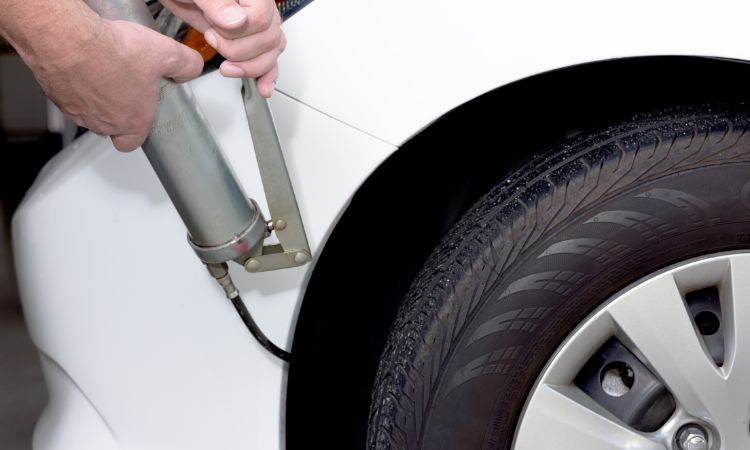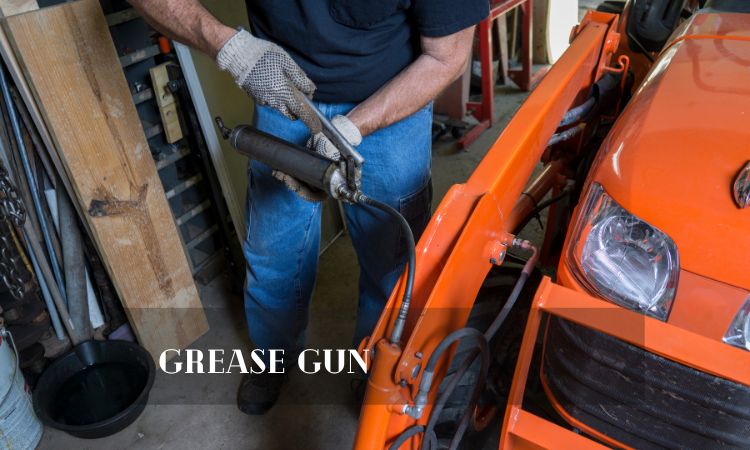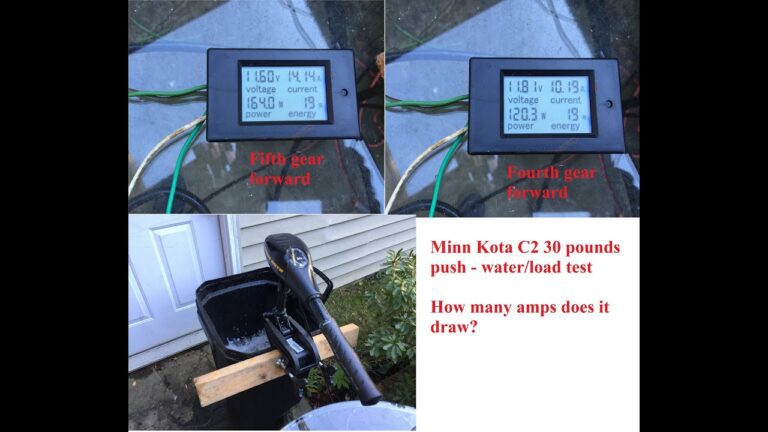Why Does My Grease Gun Get Stuck in the Fitting – 3 Solution
When working with a grease gun, it is not uncommon for the gun to become stuck in the fitting. There are several reasons why this may happen, but the most common reason is because of an air bubble that has formed in the line. When this happens, it prevents the grease from flowing through and causes the gun to become stuck.
Your grease gun may be getting stuck in the fitting because of a few different reasons. The most common reason is that there is old, hardened grease build-up inside the gun or in the fitting itself. This can happen if you don’t regularly clean your gun and/or fittings.
Another possibility is that the O-ring or other seals in the gun are damaged or worn out, causing it to leak grease and get sticky. Finally, it could be that your grease gun’s pump mechanism is faulty or broken, making it difficult to release the pressure needed to remove the gun from the fitting. Whatever the reason, it’s important to identify why your grease gun is getting stuck so you can fix the problem and prevent further damage.
Why Does Grease Gun Get Stuck on Zerk

If you’ve ever worked with a grease gun, you know that one of the most frustrating things is when it gets stuck on the zerk. There are a few reasons why this happens, and thankfully there are also a few ways to fix it. One reason your grease gun might be getting stuck on the zerk is that there is dirt or debris in the way.
This is usually easy to fix – just clean out the area around the zerk and try again. If that doesn’t work, then it’s likely that the O-ring inside the grease gun is damaged or dried out. This will require replacing the O-ring (which you can do yourself if you’re handy) or taking it to a professional.
Another reason your grease gun might get stuck on the zerk is that there isn’t enough lubricant in it. This can happen if you haven’t used your grease gun in awhile and all of the lubricants has gone dry. To fix this, simply fill up your grease gun with fresh lubricant and try again.
You may need to pump it a few times to get things going, but eventually, it should start working properly again. If your grease gun continues to get stuck on the zerk even after trying these solutions, then it’s time to replace it with a new one. Thankfully, they’re not too expensive and can be found at most hardware stores.
With a little bit of troubleshooting, you should be able to get your old trusty grease gun working like new again in no time!
Grease Gun Coupler Adjust
If you own a grease gun, then you know that one of the most important parts of the gun is the coupling. The coupling is what connects the grease gun to the grease fittings on your machinery. Over time, the coupling can become worn or damaged, which can cause problems with your grease gun.
That’s why it’s important to know how to adjust a grease gun coupling. The first thing you need to do is remove the old coupling from the grease gun. To do this, unscrew the retaining ring that holds the coupling in place.
Once the ring is removed, you can pull out the old coupling. Next, take a look at the new coupling that you will be installing. There are two parts to a new coupling: The body and The nipple.
Make sure that these two parts are screwed together tightly before proceeding. Now it’s time to install the new coupling on your grease gun. First, screw on The body of the new coupling until it is tight against the threads on the back of the barrel.
Next, insert The nipple of the new coupling into the opening in the front of the barrel. Finally, screw on The retaining ring until it is snug against The body of the new coupling. That’s all there is to it!
You’ve now successfully adjusted your grease gun coupler.
Grease Gun Fitting

A grease gun fitting is a type of mechanical seal that is used to connect a grease gun to a lubrication system. The fitting consists of two parts: a male and a female end. The male end has a tapered thread that mates with the female end’s matching thread.
An O-ring or gasket seals the connection between the two parts. There are three main types of grease gun fittings: straight, elbow, and swivel. Straight fittings are the most common and are used to connect the grease gun to a lubrication point that is in line with the gun.
Elbow fittings are used when the lubrication point is not in line with the gun, such as when greasing an axle shaft. Swivel fittings have a ball joint that allows for movement in all directions, making them ideal for hard-to-reach lubrication points. When selecting a grease gun fitting, it is important to choose one that is compatible with both the grease gun and the lubrication system.
Incompatible fittings can cause leaks or breakages. It is also important to select a fitting that has been designed for high-pressure applications if the greasing system will be operating at high pressures.
Grease Gun Tip Assembly
If you’re like most people, you probably don’t think much about your grease gun until it stops working. Then you have to figure out what’s wrong and how to fix it. One of the most common problems with grease guns is a clogged tip assembly.
This can happen for a number of reasons, but fortunately, it’s usually an easy problem to fix. The first thing you need to do is remove the old tip assembly from the grease gun. You’ll likely find that it’s full of old grease and debris.
Once you’ve removed it, clean it out thoroughly with some solvent. Be sure to also clean the inside of the barrel where the assembly fits. Once everything is clean, reassemble the parts and try again.
If your grease gun still isn’t working properly, there could be a problem with the pump or other parts. Consult your owner’s manual or take it to a professional for further diagnosis and repair.
Grease Fitting Removal Tool
If you work on vehicles, then you know how important it is to have the right tools for the job. When it comes time to remove a grease fitting, you need a tool that can get the job done quickly and efficiently. The Grease Fitting Removal Tool is just what you need.
This handy tool makes removing grease fittings a breeze. It features a durable construction that can withstand even the toughest jobs. The comfortable grip ensures that you can keep a firm hold on the tool while you’re working.
Best of all, this tool is affordable, so you won’t have to break the bank to get your hands on one.
Whether you’re a professional mechanic or a DIYer, the Grease Fitting Removal Tool is a must-have for anyone who works on vehicles. Get yours today and make your next grease fitting removal job easier than ever before!

Credit: toolsmechanism.com
How Do You Free Up a Stuck Grease Fitting?
If you have ever worked with machinery, then you know that grease fittings can become stuck from time to time. When this happens, it can be a real pain to get the fitting unstuck. Here are a few tips on how to free up a stuck grease fitting:
1. Use a pair of pliers to grip the end of the fitting. Try twisting it back and forth until it comes loose.
2. If the above method doesn’t work, try using a hammer to lightly tap on the end of the fitting. This may loosen it up enough for you to twist it out with your hand.
3. Another option is to use a drill bit that is slightly smaller than the outside diameter of the grease fitting. Drill into the end of the fitting until you reach the threads inside.
Then, use a screwdriver or other tool to unscrew the fitting from its hole.
How Do You Detach a Grease Gun?
Assuming you are talking about a grease gun that is used for automotive purposes, there are generally two ways to detach it. The first way is to release the pressure on the gun by opening the release valve. Once the pressure is released, you can then unscrew the gun from the fitting.
The second way is to use a grease gun coupler tool. This tool attaches to the grease gun and allows you to quickly and easily release the pressure and unscrew the gun from the fitting.
Are There Different Fittings for Grease Guns?
Are there different fittings for grease guns? Yes, there are. Different grease guns have different types of fittings that they use in order to work properly.
The most common type of fitting is the standard zerk fitting, which is a threaded fitting that connects to the grease gun and allows it to pump grease into whatever it is attached to. There are also quick-disconnect fittings, which as the name suggests, allow you to quickly and easily disconnect the grease gun from what it is attached to. There are also swivel fittings, which allow you to rotate the angle of the grease gun so that you can get to hard-to-reach places.
Why is My Grease Fitting Not Taking Grease?
If your grease fitting is not taking grease, there are a few possible reasons. First, check to see if the grease fitting is plugged in. If it is, clean it out with a wire brush or compressed air.
Next, make sure that the grease gun is filled with fresh grease. If the gun is empty or the grease is old and hardened, this can prevent new grease from being forced into the fitting. Finally, check the pressure in the gun to ensure that it’s high enough to force new grease into the fitting.
How to grease, and remove a stuck grease gun from a fitting
Conclusion
If you’re having trouble getting your grease gun to fit into the fitting, there are a few things you can try. First, make sure that the O-ring on the grease gun is properly lubricated. Second, check to see if the threads on the grease gun and fitting are clean and free of debris.
Finally, if all else fails, try using a different type of grease gun.


